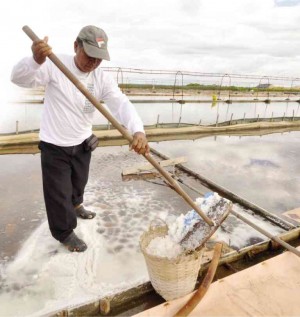Salt farm offers weekend getaway from daily work

A WORKER harvests salt from a salt bed in a farm on Tambac Bay in Bolinao, Pangasinan. WILLIE LOMIBAO / CONTRIBUTOR
Ever wondered how salt is made? A daylong agri-ecotourism tour in Bolinao town in Pangasinan province will not only give visitors the answer, but it will also let them experience salt harvesting and more.
Pacific Farms Inc. (PFI), a 500-hectare salt farm in Barangay (village) Zaragoza, had opened its gates to tourists wanting a unique educational adventure.
“There’s nothing like this. There’s nothing like this in Hong Kong, in Singapore. There’s nothing like this in Kuala Lumpur. It is only us [who have this kind of tour],” says Johnny Khonghun, president and chief executive of Pacific Farms.
The farm tour begins early morning and visitors are taken to a view deck, where they can see the salt farm on Tambac Bay, a body of water separating Bolinao and the island town of Anda.
“Here, you will experience the sunrise overlooking the salt farm. This is where we communicate to visitors that salt is produced through these three gifts from God—the sun, the sea and the soil. We added the farmers’ sweat, which is symbolic of their hard work to produce salt,” says Glen Khonghun, PFI human resources chief.
Article continues after this advertisement“We also discuss in the view deck why we produce a high quality salt here. It’s because of the farm’s position. The brine from the bay is better compared to other places. We discovered that what we are getting is actually mineral sea salt,” says Christopher Tiongson, tour coordinator.
Article continues after this advertisementFrom the view deck, visitors drive down the hill to the ruins of a chapel destroyed by Typhoon “Emong” in 2009. Despite its present condition, the place is still sacred to salt farmers because “it was a test of their faith,” Tiongson said.
Mass is still held there every end of October at the start of the harvest season.
As visitors enter the farm, they have to cross a wooden bridge salt that farmers call “love bridge.”
Salt production
The bridge is historic because, Tiongson says, it was at its other end where irate farmers had tried to block Khonghun when he first entered the farm in 1993 as the new company owner.
“The situation was tense then because the farmers wanted to know if they would be retained or fired. And they were asking for wages and benefits not paid by the previous management,” Tiongson says.
The farmers’ anger was defused when a goat gave birth in the middle of the bridge. To them, Tiongson says, that symbolized a new beginning for the company.
But more than the glimpse of the company’s historical landmarks, the tour gets more exciting as visitors see the salt beds glistening with powdery white crystals under the sun.
They watch farmers as they harvest the salt from the beds and put them into bamboo baskets. They are then handed wooden rakes to experience salt harvesting.
“Once they see how hard it is to harvest salt, visitors begin to appreciate the importance of salt,” says Tiongson.
From the salt beds, tourists learn that the water where salt is produced comes from a 10-hectare impounding lake nearby.
“Water from the sea enter the lake. Because of the high concentration of minerals, the water temperature is 70 degrees Celsius, enough to boil an egg,” says Tiongson.
Glen Khonghun says duck eggs are usually submerged in the lake three days before the arrival of tourists.
“The eggs are part of the snack. These eggs, after three days of being submerged in the salt lake, absorb the minerals, making them very nutritious, giving a person a lot of energy,” Khonghun says.
A short uphill ride to the farm’s administrative building passes through rows and rows of mahogany trees that farmers had planted.
The mini-forest also serves as a picnic park and visitors are given seedlings to plant there before they leave the farm.
Just in front of the administrative building, the farm’s oldest building, is a two-story high salt mountain. Visitors are allowed to climb, play, take pictures and shovel the salt into a sack.
“It’s a getaway from your normal or your everyday work. You don’t meet a salt farmer every day and you don’t see a salt mountain every day in your life,” says Khonghun.